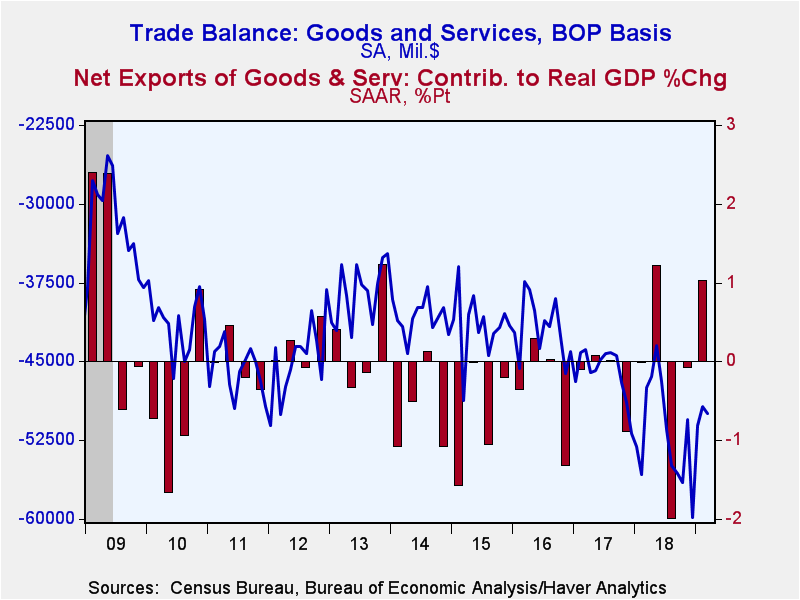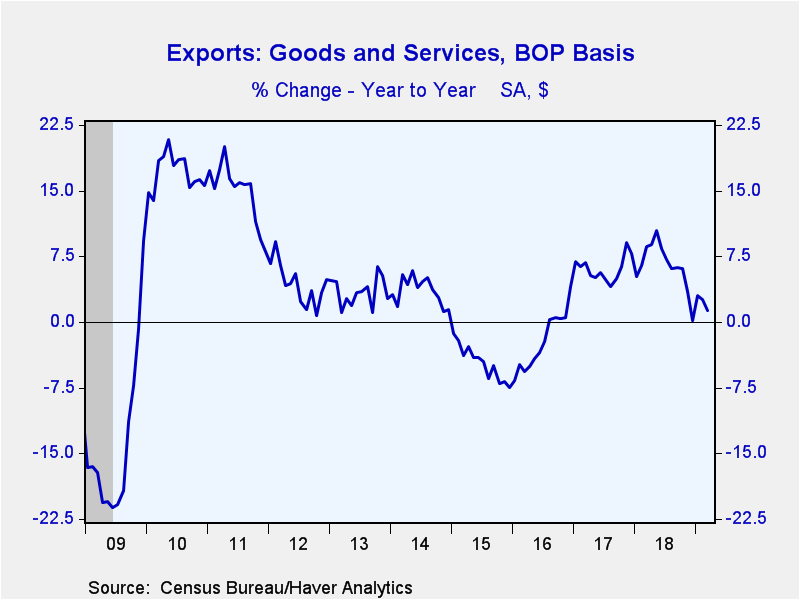 Global| May 09 2019
Global| May 09 2019U.S. Trade Deficit Widens Slightly in March
by:Sandy Batten
|in:Economy in Brief
Summary
The U.S. trade deficit in goods and services widened slightly in March to $50.0 billion from $49.3 billion in February. This was spot on expectations of a $50.0 billion deficit from the Action Economics Survey. Exports rose 1.0% m/m [...]
The U.S. trade deficit in goods and services widened slightly in March to $50.0 billion from $49.3 billion in February. This was spot on expectations of a $50.0 billion deficit from the Action Economics Survey. Exports rose 1.0% m/m (1.3% y/y) versus 1.2% m/m in February. Imports picked up a bit, rising 1.1% m/m (2.1% y/y) in March after a 0.3% m/m gain in February. The goods deficit widened marginally to $72.4 billion in March from $71.9 billion in February while the services surplus was little changed at $22.4 billion. For the first quarter, the deficit narrowed markedly to $150.4 billion from $167.0 billion in Q4.
Goods exports increased 1.5% m/m in March, the same monthly gain as in February. The March increase was led by a 7.1% m/m jump in food exports (some revival in soybean exports to China) and a 4.0% m/m rise in exports of industrial supplies, the first monthly increase in five months. In contrast, exports of capital goods receded 1.1% m/m in March while automotive exports slipped 0.4% m/m, after having posted significant increases in both January and February.
Imports of goods rose 1.2% m/m in March following a 0.4% m/m increase in February. The March figures were led by a sharp rise in food imports, up 8.2% m/m for the largest monthly rise since March 2014. Imports of industrial supplies were also strong in March, rising 5.6% m/m for the first monthly increase in seven months. A 1.2% m/m drop in consumer goods imports (accounted for by a decline in imports of cell phones and other household goods) was the only meaningful drag on imports in March.
Petroleum imports surged 11.9% m/m in March on top of a 4.9% m/m gain in February. A good portion of the increase was due to higher prices for crude oil imports, which jumped up 13.2% in March to $53.10 per barrel. Even with the sharp price increase, real petroleum imports were up 4.4% m/m versus a 4.9% m/m decline in February. Nonpetroleum imports rose 0.4% m/m in March following a tepid 0.1% m/m increase in February.
Turning to services flows, exports of services edged up 0.1% m/m in March after a 0.5% m/m increase in February. Exports of maintenance and repair services (+3.2% m/m) exhibited the most monthly strength while exports of transport services were weak (-1.9% m/m). Services imports rose 0.5% m/m in March, offsetting the 0.4% m/m decline in February. The March increase was led by maintenance and repair services (+10.9% m/m) with a drag from the import of insurance (-2.4% m/m).
The trade deficit with China narrowed sharply for the third consecutive month--to $28.3 billion from $30.1 billion, its narrowest since April 2016. Exports jumped 15.1% m/m while imports slipped 1.2% m/m. The trade deficit with the European Union widened meaningfully to $15.8 billion from $12.4 billion in February.
The international trade data as well as oil prices can be found in Haver's USECON database. Detailed figures on international trade are available in the USINT database. The expectations figures are from the Action Economics Forecast Survey, which is carried in AS1REPNA.
| Foreign Trade in Goods & Services (Current $) | Mar | Feb | Jan | Mar Y/Y | 2018 | 2017 | 2016 |
|---|---|---|---|---|---|---|---|
| U.S. Trade Deficit ($ bil.) | 50.00 | 49.29 | 51.13 | 47.45 (3/18) |
622.11 | 552.28 | 502.00 |
| Exports of Goods & Services (% Chg) | 1.0 | 1.2 | 1.0 | 1.3 | 6.4 | 6.1 | -2.2 |
| Imports of Goods & Services (% Chg) | 1.1 | 0.3 | -2.6 | 2.1 | 7.6 | 6.8 | -1.7 |
| Petroleum (% Chg) | 11.9 | 4.9 | -6.2 | -6.8 | 21.0 | 27.2 | -19.5 |
| Nonpetroleum Goods (% Chg) | 0.4 | 0.1 | -2.8 | 2.5 | 7.5 | 5.6 | -1.2 |
Sandy Batten
AuthorMore in Author Profile »Sandy Batten has more than 30 years of experience analyzing industrial economies and financial markets and a wide range of experience across the financial services sector, government, and academia. Before joining Haver Analytics, Sandy was a Vice President and Senior Economist at Citibank; Senior Credit Market Analyst at CDC Investment Management, Managing Director at Bear Stearns, and Executive Director at JPMorgan. In 2008, Sandy was named the most accurate US forecaster by the National Association for Business Economics. He is a member of the New York Forecasters Club, NABE, and the American Economic Association. Prior to his time in the financial services sector, Sandy was a Research Officer at the Federal Reserve Bank of St. Louis, Senior Staff Economist on the President’s Council of Economic Advisors, Deputy Assistant Secretary for Economic Policy at the US Treasury, and Economist at the International Monetary Fund. Sandy has taught economics at St. Louis University, Denison University, and Muskingun College. He has published numerous peer-reviewed articles in a wide range of academic publications. He has a B.A. in economics from the University of Richmond and a M.A. and Ph.D. in economics from The Ohio State University.










